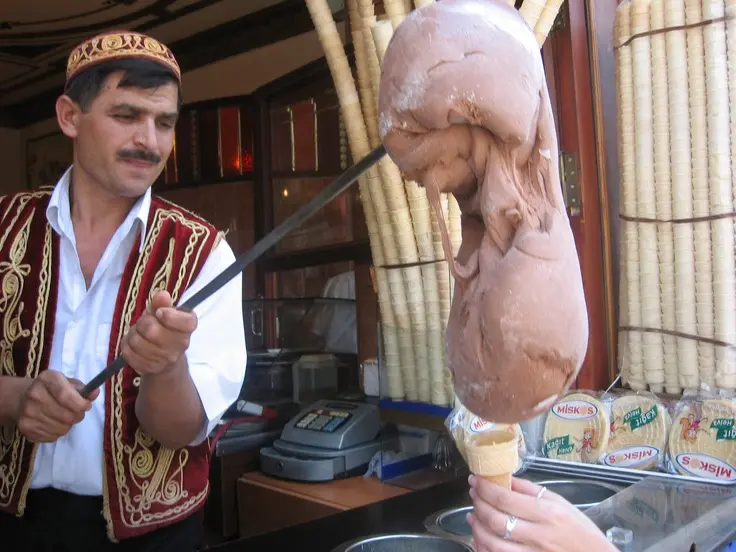Kütür Kütür

The CASE FILE series — to which SEMIOVOX has invited our semiotician colleagues from around the world to contribute — shares memorable case studies via story telling.
One of the most rewarding aspects of working in semiotics is the opportunity to immerse oneself in the rich sensory codes that define a culture. My exploration of the Turkish ice cream market was one such project — delightful in its subject matter, yet deeply revealing in its insights about language and texture.
Ice cream, as a product, is often reduced to its commercial form in most parts of the world. It’s easy to forget that ice cream existed in its local, artisanal forms before multinational brands dominated the scene. In Turkey, that local variant is Maraş dondurması, a traditional ice cream made from goat’s milk, sugar, and orchid bulb powder (salep). This recipe gives it an elasticity and chewiness that sets it apart from the softer, creamier textures of commercial ice creams.
Internationally recognised for the playful antics of its vendors, dressed in Ottoman garb and using long, spear-like scoops, the experience of buying this ice cream goes beyond taste — it taps into a cultural performance of texture, playfulness, and surprise. Yet there is more beneath the surface. What truly distinguishes Maraş dondurması is its sensory experience.
As part of a broader study into Turkish desserts and their sensory profiles, I encountered a moment of revelation when I focused on the texture of the ice cream cone. While trying to describe the crispiness of a cone, I realised that Turkish has an extraordinary range of words — reflective reduplication words — that depict the texture of food, especially crunchiness and crispiness, in a way that (as far as I know) few other languages do.
For instance, words like çıtır çıtır, kıtır kıtır, and kütür kütür span a spectrum of texture from delicate crispiness to dense crunchiness. These onomatopoeic expressions aren’t just a playful use of language; they are essential in describing how something feels when eaten or touched. These words capture texture’s essence in a way that is deeply rooted in Turkish culture.
This study made me realise how integral linguistic expression is in conveying sensory experience and how the breadth of a language’s descriptive range reveals what that culture values. Just as Eskimos have dozens of words for snow, Turkish has a rich lexicon to describe textures like crispiness and crunchiness — elements crucial to their culinary and cultural identity.
For me, the project wasn’t just about ice cream or language. It was a reminder of how sensory codes, deeply embedded in a culture’s linguistic structure, reveal the significance of everyday experiences. The Turkish language reflects a profound connection between sound and sensation, a link I might have never fully appreciated if it weren’t for this deep dive into the world of ice cream.
CASE FILE: Sónia Marques (Portugal) on BIRTHDAY CAKE | Malcolm Evans (Wales) on PET FOOD | Charles Leech (Canada) on HAGIOGRAPHY | Becks Collins (England) on LUXURY WATER | Alfredo Troncoso (Mexico) on LESS IS MORE | Stefania Gogna (Italy) on POST-ANGEL | Mariane Cara (Brazil) on MOTHER-PACKS | Whitney Dunlap-Fowler (USA) on WHERE THE BOYS ARE | Antje Weißenborn (Germany) on KITSCH | Chirag Mediratta (India) on “I WATCH, THEREFORE I AM” | Eugene Gorny (Thailand) on UNDEAD LUXURY | Adelina Vaca (Mexico) on CUBAN WAYS OF SEEING | Lucia Laurent-Neva (England) on DOLPHIN SQUARE | William Liu (China) on SCENT FANTASY | Clio Meurer (Brazil) on CHOCOLATE IDEOLOGY | Samuel Grange (France) on SWAZILAND CONDOMS | Serdar Paktin (Turkey/England) on KÜTUR KÜTUR | Ximena Tobi (Argentina) on SLUM PANDEMIC | Maciej Biedziński (Poland) on YOUTH LEISURE | Josh Glenn (USA) on THE AMERICAN SPIRIT | Martha Arango (Sweden) on M | Chris Arning (England) on X | Peter Glassen (Sweden) on WHEN SHABBY ISN’T CHIC | Joël Lim Du Bois (Malaysia) on RECONSTRUCTION SET | Ramona Lyons (USA) on THE FALL.
Also see these global semio series: MAKING SENSE (Q&As) | SEMIOFEST SESSIONS (monthly mini-conferences) | COVID CODES | SEMIO OBJECTS | COLOR CODEX | DECODER (fictional semioticians) | CASE FILE | PHOTO OP | MEDIA DIET | TATTOO YOU (semioticians’ tattoos).

